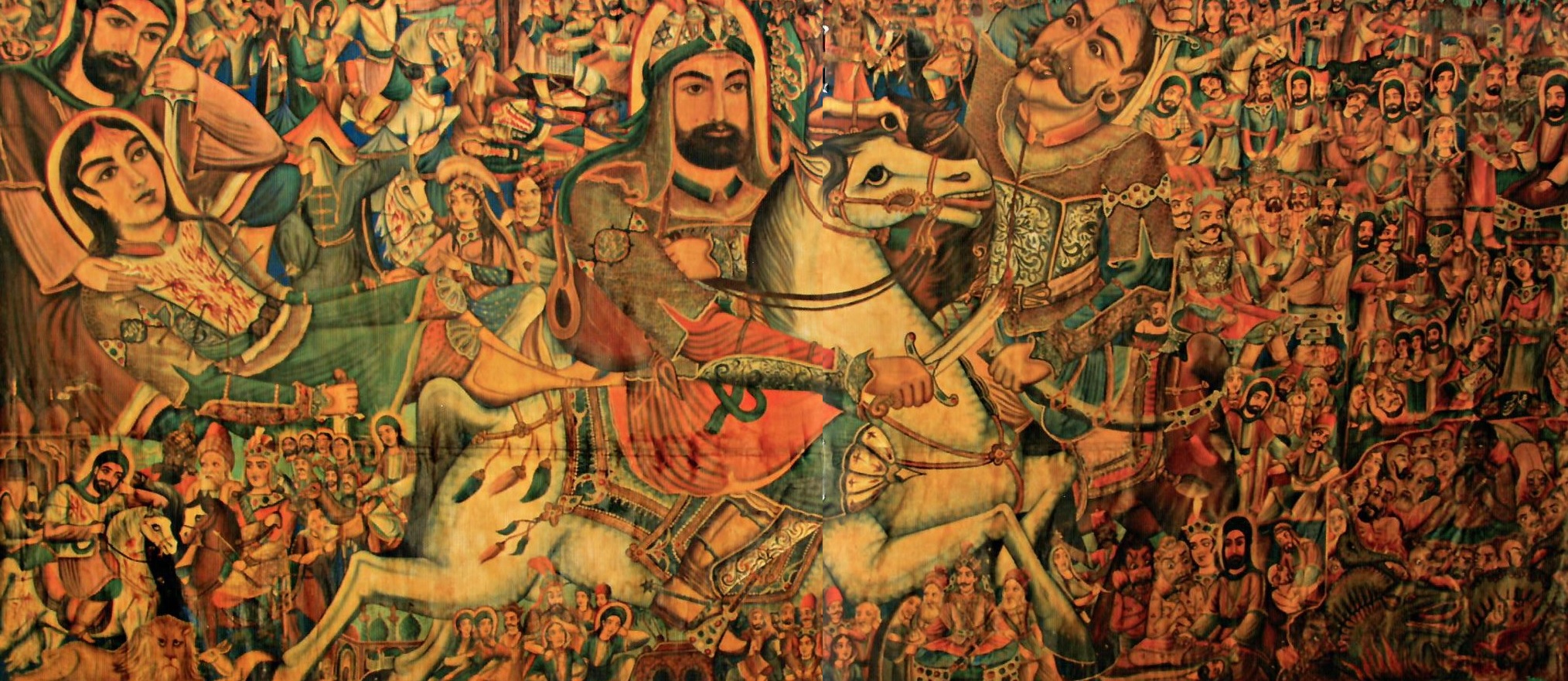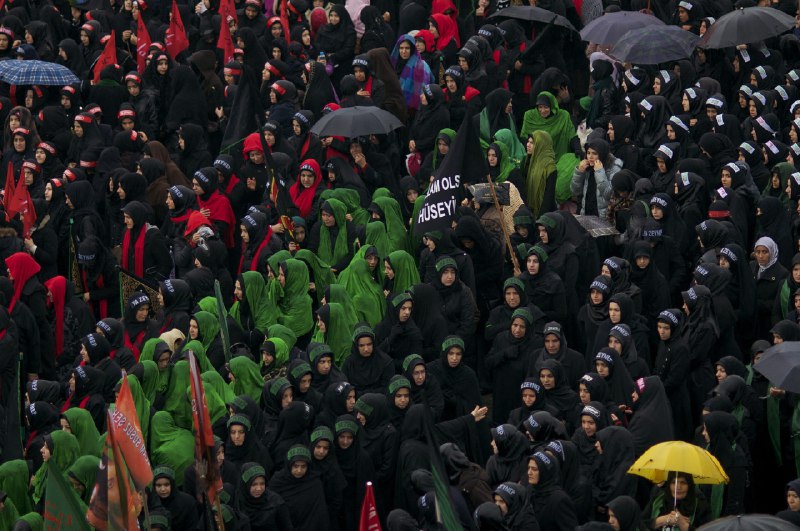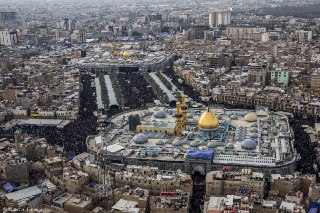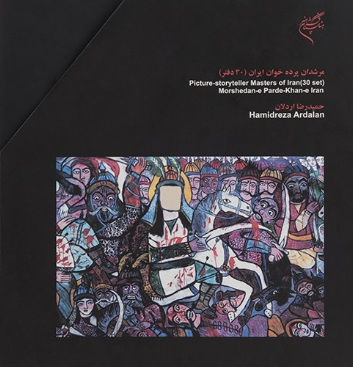- Shahada
- Ahl Al-Bayt
- Karbala (pictured)
- Ta'ziya
- Ziara
Test: Difference between revisions
Jump to navigation
Jump to search
 The curtain used by murshed Khandan, is illustrated by Ostad (acknowledged master) Hossein Hamedani, and dates back more than 50 years. The length of the curtain (Parde) is about 4 metres, and is one of the largest of its kind. The Parde has many faces and gatherings painted upon it. The Darvish curtains are fixed in its generalities but may be varied in details.
The curtain used by murshed Khandan, is illustrated by Ostad (acknowledged master) Hossein Hamedani, and dates back more than 50 years. The length of the curtain (Parde) is about 4 metres, and is one of the largest of its kind. The Parde has many faces and gatherings painted upon it. The Darvish curtains are fixed in its generalities but may be varied in details.
mNo edit summary |
mNo edit summary |
||
| Line 35: | Line 35: | ||
Works | Works | ||
| image =Picture-storyteller masters of iran.png | | image =Picture-storyteller masters of iran.png | ||
| text = [[ | | text = The “[[Picture-storyteller Masters of Iran]]” was written by Hamid Reza Ardalan, musician and scholar of ritual arts of Iran, in thirty volumes. This work introduces thirty Pardekhans who are among the remaining generation of picture-storytellers. This book is the result of ten years of library research and field work of the author. Each volume of this series is around 25 picture pages and includes an introduction and analysis of one of the picture-storytellers. The book and CD, as a contribution to preserving ritual arts and oral heritage of Iran, have been published by “Farhagestan-e Honar” in both English and Persian languages. | ||
[[Picture-storyteller Masters of Iran|Full Article...]] | |||
}}{{ | }}{{ | ||
CirclePersons | CirclePersons | ||
Revision as of 12:24, 4 September 2019
Welcome to Wikihussain
- • Literature
- • Geography
- • Art
- • History
- • Religions and Denominations
- • Cultural Studies
Featured Article
 'Ashura is the tenth day of Muharram (the first month of the Islamic calendar). It is the climax of the Muharram mourning rituals which commemorates the martyrdom of Hussain ibn Ali, the grandson of the prophet of Islam, Muhammad at the Battle of Karbala on 10 Muharram in the year 61 AH. For Sunnis, it is a day on which fasting is recommended. The root of the word Ashura has the meaning of tenth in Semitic languages. The Arabic term derives from the Hebrew word ʿasor with the Aramaic determinative ending -ā. It refers broadly to the first ten days of Muharram, but more specifically to the tenth day.
Full Article...
'Ashura is the tenth day of Muharram (the first month of the Islamic calendar). It is the climax of the Muharram mourning rituals which commemorates the martyrdom of Hussain ibn Ali, the grandson of the prophet of Islam, Muhammad at the Battle of Karbala on 10 Muharram in the year 61 AH. For Sunnis, it is a day on which fasting is recommended. The root of the word Ashura has the meaning of tenth in Semitic languages. The Arabic term derives from the Hebrew word ʿasor with the Aramaic determinative ending -ā. It refers broadly to the first ten days of Muharram, but more specifically to the tenth day.
Full Article...
Did you know
- WikiHussain is a collaborative online encyclopedia which brings together available resources from around the world to provide the most reliable collection of information on the web on the topic of the third Imam, Hussain ibn Ali. The organization initially kicked off in Spring 2016, with Farsi as its initial language. It is hoped that with the cooperation of all those who are interested in this topic, more academic and high0standard resources are converged into making the most reliable and inclusive encyclopedia about Hussain ibn Ali and related topics. Available entries are selected based on their relation to the topic, their quality of content, and their authors. Enhancing the quality of the content and adding to the languages are some of the top goals in production of this encyclopedia.
- Full Article...
Featured art Works
The “Picture-storyteller Masters of Iran” was written by Hamid Reza Ardalan, musician and scholar of ritual arts of Iran, in thirty volumes. This work introduces thirty Pardekhans who are among the remaining generation of picture-storytellers. This book is the result of ten years of library research and field work of the author. Each volume of this series is around 25 picture pages and includes an introduction and analysis of one of the picture-storytellers. The book and CD, as a contribution to preserving ritual arts and oral heritage of Iran, have been published by “Farhagestan-e Honar” in both English and Persian languages.
Full Article...
Persons
Featured Art
 The curtain used by murshed Khandan, is illustrated by Ostad (acknowledged master) Hossein Hamedani, and dates back more than 50 years. The length of the curtain (Parde) is about 4 metres, and is one of the largest of its kind. The Parde has many faces and gatherings painted upon it. The Darvish curtains are fixed in its generalities but may be varied in details.
The curtain used by murshed Khandan, is illustrated by Ostad (acknowledged master) Hossein Hamedani, and dates back more than 50 years. The length of the curtain (Parde) is about 4 metres, and is one of the largest of its kind. The Parde has many faces and gatherings painted upon it. The Darvish curtains are fixed in its generalities but may be varied in details.

